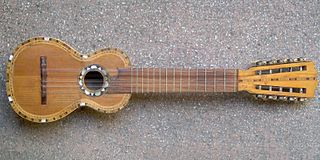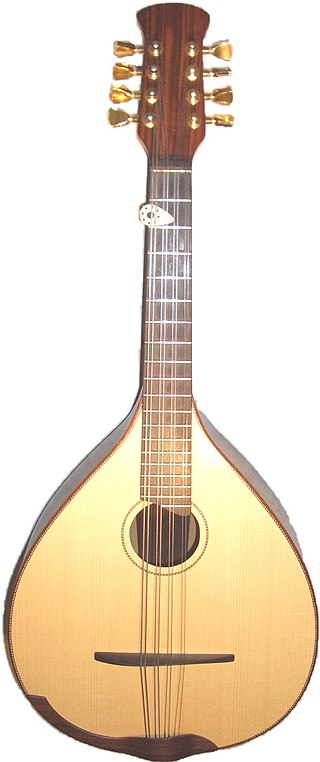
The guitar is a stringed musical instrument, that is usually fretted and typically has six or twelve strings. It is usually held flat against the player's body and played by strumming or plucking the strings with the dominant hand, while simultaneously pressing selected strings against frets with the fingers of the opposite hand. A guitar pick may also be used to strike the strings. The sound of the guitar is projected either acoustically, by means of a resonant hollow chamber on the guitar, or amplified by an electronic pickup and an amplifier.

A mandolin is a stringed musical instrument in the lute family and is generally plucked with a pick. It most commonly has four courses of doubled strings tuned in unison, thus giving a total of eight strings. A variety of string types are used, with steel strings being the most common and usually the least expensive. The courses are typically tuned in an interval of perfect fifths, with the same tuning as a violin. Also, like the violin, it is the soprano member of a family that includes the mandola, octave mandolin, mandocello and mandobass.

In music, there are two common meanings for tuning:

The charango is a small Andean stringed instrument of the lute family, from the Quechua and Aymara populations in the territory of the Altiplano in post-Colonial times, after European stringed instruments were introduced by the Spanish during colonialization. The instrument is widespread throughout the Andean regions of Bolivia, Peru, Ecuador, northern Chile and northwestern Argentina, where it is a popular musical instrument that exists in many variant forms.

The bouzouki is a musical instrument popular in Greece. It is a member of the long-necked lute family, with a round body with a flat top and a long neck with a fretted fingerboard. It has steel strings and is played with a plectrum producing a sharp metallic sound, reminiscent of a mandolin but pitched lower. There are two main types of bouzouki: the trichordo (three-course) has three pairs of strings and the tetrachordo (four-course) has four pairs of strings. The instrument was brought to Greece in the early 1900s by Greek refugees from Anatolia, and quickly became the central instrument to the rebetiko genre and its music branches. It is now an important element of modern Laïko pop Greek music.

The mandola (US and Canada) or tenor mandola (Ireland and UK) is a fretted, stringed musical instrument. It is to the mandolin what the viola is to the violin: the four double courses of strings tuned in fifths to the same pitches as the viola (C3-G3-D4-A4), a fifth lower than a mandolin. The mandola, though now rarer, is an ancestor of the mandolin. (The word mandolin means little mandola.)

A twelve-string guitar is a steel-string guitar with 12 strings in six courses, which produces a thicker, more ringing tone than a standard six-string guitar. Typically, the strings of the lower four courses are tuned in octaves, with those of the upper two courses tuned in unison. The gap between the strings within each dual-string course is narrow, and the strings of each course are fretted and plucked as a single unit. The neck is wider, to accommodate the extra strings, and is similar to the width of a classical guitar neck. The sound, particularly on acoustic instruments, is fuller and more harmonically resonant than six-string instruments. The 12-string guitar can be played like a 6-string guitar as players still use the same notes, chords and guitar techniques like a standard 6-string guitar, but advanced techniques might be tough as players need to play or pluck two strings simultaneously.

The acoustic bass guitar is a bass instrument with a hollow wooden body similar to, though usually larger than, a steel-string acoustic guitar. Like the traditional electric bass guitar and the double bass, the acoustic bass guitar commonly has four strings, which are normally tuned E-A-D-G, an octave below the lowest four strings of the 6-string guitar.

A tiple, is a plucked typically 12-string chordophone of the guitar family. A tiple player is called a tiplista. The first mention of the tiple comes from musicologist Pablo Minguet e Irol in 1752. Although many variations of the instrument exist, the tiple is mostly associated with Colombia, and is considered the national instrument. The Puerto Rican version characteristically has fewer strings, as do variants from Cuba, Mallorca, and elsewhere among countries of Hispanic origin.

The mandocello is a plucked string instrument of the mandolin family. It is larger than the mandolin, and is the baritone instrument of the mandolin family. Its eight strings are in four paired courses, with the strings in each course tuned in unison. Overall tuning of the courses is in fifths like a mandolin, but beginning on bass C (C2). It can be described as being to the mandolin what the cello is to the violin.
A contrabass guitar is a low-register bass guitar with four, five or six strings. It is often called, simply, a six string bass guitar. The five string bass guitar is rarely called a contrabass guitar, even though it typically has the same lowest note.

A course, on a stringed musical instrument, is either one string or two or more adjacent strings that are closely spaced relative to the other strings, and typically played as a single string. The strings in each multiple-string course are typically tuned in unison or an octave.

The electric mandolin is an instrument tuned and played as the mandolin and amplified in similar fashion to an electric guitar. As with electric guitars, electric mandolins take many forms. Most common is a carved-top eight-string instrument fitted with an electric pickup in similar fashion to many archtop semi-acoustic guitars. Solid body mandolins are common in 4-, 5-, and 8-string forms. Acoustic electric mandolins also exist in many forms.

The octave mandolin or octave mandola is a fretted string instrument with four pairs of strings tuned in fifths, G−D−A−E, an octave below a mandolin. It is larger than the mandola, but smaller than the mandocello and its construction is similar to other instruments in the mandolin family. Usually the courses are all unison pairs but the lower two may sometimes be strung as octave pairs with the higher-pitched octave string on top so that it is hit before the thicker lower-pitched string. Alternate tunings of G−D−A−D and A−D−A−D are often employed by Celtic musicians.
The cuatro is a family of Latin American string instruments played in Colombia, Puerto Rico, Venezuela and other Latin American countries. It is derived from the Spanish guitar. Although some have viola-like shapes, most cuatros resemble a small to mid-sized classical guitar. In Puerto Rico and Venezuela, the cuatro is an ensemble instrument for secular and religious music, and is played at parties and traditional gatherings.

The Rickenbacker 360/12 is the Rickenbacker company's 12-string variant of their 360 electric guitar model. Mainly known for producing "jangly" sounds, it was among the first electric 12-string guitars. The 360/12 was given worldwide attention when George Harrison used it on many Beatles recordings, introducing the distinctive new sound of this guitar on "I Call Your Name", which the band recorded in March 1964. In the late 1960s, the company made alternative models such as the Rickenbacker 370/12, which became the favored instrument of Roger McGuinn of the Byrds.

Each bass guitar tuning assigns pitches to the strings of an electric bass. Because pitches are associated with notes, bass-guitar tunings assign open notes to open strings. There are several techniques for accurately tuning the strings of an electric bass. Bass method or lesson books or videos introduce one or more tuning techniques, such as:

The Mandobass is the largest member of the mandolin family, sometimes used as the bass instrument in mandolin orchestras. It is so large that players usually hold it like a double bass—upright and supported on an endpin that rests on the floor. The neck-scale length on a full-size mando-bass is similar to that of a standard orchestral double bass viol: about 43 inches (110 cm). The instrument is otherwise similar to the smaller, higher-pitched members of the mandolin family, having a fretted neck, a headstock with geared tuning machines, and a large resonating body often—but not always—shaped like other mandolins.
A nine-string guitar is a guitar with nine strings instead of the commonly used six strings. Such guitars are not as common as the six-string variety, but are used by guitarists to modify the sound or expand the range of their instrument.

The Algerian mandole is a steel-string fretted instrument resembling an elongated mandolin, widely used in Algerian music such as Chaabi, Kabyle music and Nuubaat.
















